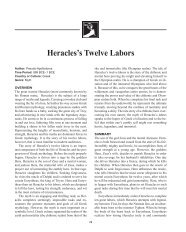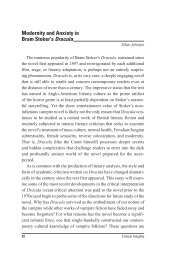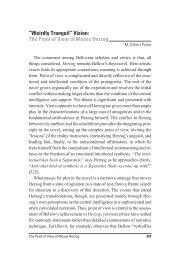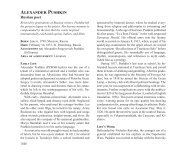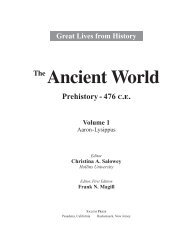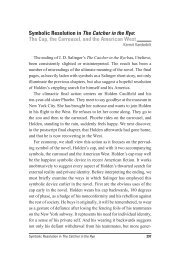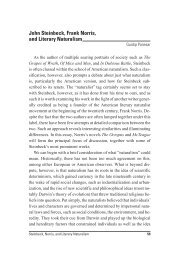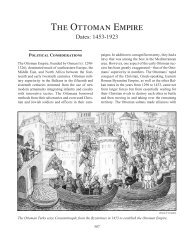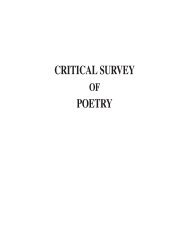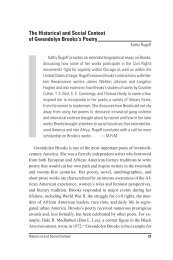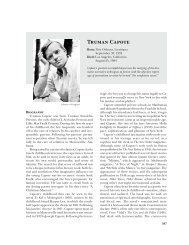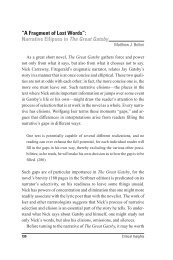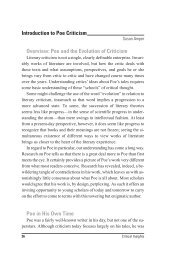Gabriel García Márquez: Cultural and Historical ... - Salem Press
Gabriel García Márquez: Cultural and Historical ... - Salem Press
Gabriel García Márquez: Cultural and Historical ... - Salem Press
Create successful ePaper yourself
Turn your PDF publications into a flip-book with our unique Google optimized e-Paper software.
on them. In One Hundred Years of Solitude, <strong>García</strong> <strong>Márquez</strong> makes<br />
references to some of his literary forebears, including Borges, Carpentier,<br />
<strong>and</strong> Mexican author Juan Rulfo, who also influenced the style<br />
of Magical Realism with his single book Pedro Páramo.<br />
Politics were of major importance to the Boom writers. The Boom<br />
occurred during the 1960s, between the populist regimes of the 1940s<br />
<strong>and</strong> 1950s, <strong>and</strong> the devastating wave of military dictatorships in the<br />
early to mid-1970s. The 1960s was symbolized in Latin America by<br />
hope <strong>and</strong> cultural innovations, <strong>and</strong> the Cuban Revolution played a big<br />
part in the Boom’s formation. After right-wing dictatorships fell in<br />
both Venezuela <strong>and</strong> Colombia, the defeat of Cuba’s dictator Fulgencio<br />
Batista followed. Fidel Castro had secretly returned to Cuba from exile,<br />
<strong>and</strong> with a small group of followers, including Che Guevara, he<br />
fought against the brutal regime of Batista. On January 8, 1959, Castro<br />
<strong>and</strong> his supporters entered Havana in triumph. Like many Latin American<br />
intellectuals <strong>and</strong> writers, <strong>García</strong> <strong>Márquez</strong> favored the socialist revolution<br />
<strong>and</strong> was an early ally of Castro. During this exciting period of<br />
political <strong>and</strong> cultural changes, a great amount of Latin American literature<br />
appeared, helping to create the Boom.<br />
In the 1960s the success of the Latin American novel was recognized<br />
with zeal in the international world, <strong>and</strong> the Boom writers, including<br />
<strong>García</strong> <strong>Márquez</strong>, helped to develop Latin American literature.<br />
The authors benefited from English translations <strong>and</strong> the fact that their<br />
books were published in Europe <strong>and</strong> by Harper & Row in the United<br />
States, which helped to widen the readership. There were also important<br />
publishing houses based in Buenos Aires, Mexico City, Havana,<br />
<strong>and</strong> Santiago, Latin <strong>and</strong> South American cities that became strong<br />
cultural centers during this period. Furthermore, American <strong>and</strong> European<br />
universities began teaching the Latin American Boom authors,<br />
<strong>and</strong> scholars <strong>and</strong> critics took an interest in their work. Though the<br />
Boom writers’ styles were quite different, many of their literary ideas<br />
were similar, as they experimented with forms of realism <strong>and</strong> narrative<br />
structure. The four main writers of the Boom—<strong>García</strong> <strong>Márquez</strong>,<br />
22 Critical Insights



